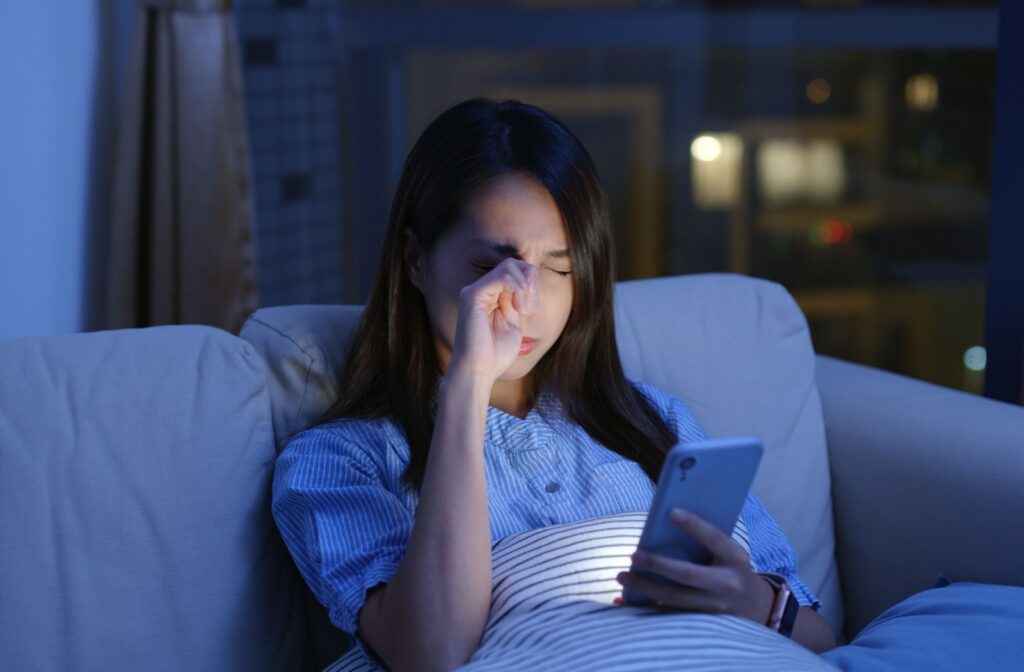You may think that dry eye just means your eyes feel dry. In fact, however, this condition involves a wide range of uncomfortable sensations. Dry eye occurs when your tears don’t provide enough lubrication for your eyes. This can lead to feelings that disrupt your work and daily life, and may even be related to headaches from eye strain.
Dry eye often feels like a gritty, stinging, or burning sensation in your eyes, sometimes accompanied by blurred vision or even excessive watering. Understanding these symptoms is the first step toward finding relief through a personalized dry eye therapy plan.
Common Sensations & Symptoms of Dry Eye
Dry eye symptoms often affect both eyes and can include a variety of symptoms that go beyond simple dryness. You might notice these sensations coming and going, or they might be persistent throughout your day.
- A stinging, burning, or scratchy feeling
- Redness and general eye irritation
- Sensitivity to light
- The sensation of having something in your eyes
- Watery eyes (the body’s response to irritation)
- Blurred vision or tired eyes
- Stringy mucus in or around the eyes
How to Tell If You Have Dry Eyes?
Certain daily experiences can point toward a dry eye condition. If you notice these signs regularly, it might be more than temporary discomfort. Paying attention to these situations can help you understand what’s happening with your eyes.
The Constant Gritty Feeling
One of the most frequent dry eye-related complaints is a gritty feeling, as if there’s sand in your eye. You might have the urge to rub your eyes for relief, but doing so can cause more irritation.
Trouble with Contact Lenses & Night Driving
If wearing contact lenses has become uncomfortable or painful, dry eye could be the cause. Contacts require a healthy tear film to stay lubricated, which means that having dry eye makes contact lenses harder to wear.
Understanding What Type of Dry Eye You Have
Not all dry eye is the same. A professional evaluation can help determine whether you’re experiencing aqueous-deficient dry eye (where your eyes don’t produce enough tears) or evaporative dry eye (where tears evaporate too quickly, often due to Meibomian gland dysfunction). Knowing the type of dry eye is essential to choosing the most effective treatment.
What Can Be Mistaken for Dry Eyes?
Symptoms like redness and irritation can also be signs of eye allergies or other conditions, such as ocular rosacea or blepharitis. The main difference often lies in the persistence of symptoms and the type of discomfort. An eye care professional can help determine the specific cause of your symptoms.
Why Dry Eye Develops
Your eyes depend on a healthy tear film with a proper balance of water, oil, and mucus to stay comfortable and clear. A problem with any of these layers may lead to dry eye symptoms. Several factors can disrupt this delicate balance.
Not Enough Tears
Sometimes, your eyes just don’t produce enough tears to stay properly lubricated. This can be related to age, hormonal changes, or certain medical conditions. Some medications for blood pressure or allergies can also reduce tear production.
Poor Quality Tears
In other cases, your body might produce plenty of poor-quality tears. If your tears lack the right amount of oil, they evaporate too quickly. This issue is often linked to Meibomian gland dysfunction (MGD), leaving the surface of your eye unprotected and dry—a common cause of watery eyes.

Simple Lifestyle Changes for Relief
You can make small adjustments to your daily routine to help ease dry eye symptoms. These proactive steps focus on adding moisture to your eyes and your environment. T
Adjust Your Environment
The air around you plays a big role in how your eyes feel. Try to avoid air blowing directly in your eyes from fans, car heaters, or air conditioners. Using a humidifier can add moisture to dry indoor air, especially during winter.
Pay Attention to Your Habits
When you focus on a task like reading or working on a computer, you tend to blink less often. To prevent eye fatigue, take periodic breaks by closing your eyes for a few minutes or following the 20-20-20 rule. Also, make sure you drink enough water throughout the day.
When At-Home Care Is Not Enough
While lifestyle changes can provide relief, they may not resolve the underlying issue. If your symptoms persist, a professional evaluation can identify the cause. This helps find a more targeted solution for your discomfort.
Will Dry Eye Fix Itself?
For many people, dry eye is a chronic condition that needs consistent management. Symptoms may improve with at-home care, but they rarely disappear completely, making dry eye treatment a marathon, not a sprint. It’s a condition to manage rather than cure.
Connect with a Professional
If your symptoms interfere with daily activities like reading or driving, it’s a good idea to talk to an eye care professional. We can measure your tear production and quality to understand what’s causing your discomfort and get to the root of the problem.
Your Options for Dry Eye Management
Based on your evaluation, we can suggest a targeted plan. This might include specific over-the-counter drops, prescription treatments, or in-office procedures like OptiLight IPL— a non-invasive, light-based treatment performed in the area below the eyes.
We also offer OptiLIFT, a treatment that combines radiofrequency and dynamic muscle stimulation for dry eye relief.
Additional dry eye treatment options may include punctal plugs to help retain moisture, amniotic membranes to support healing of the eye surface, and prescription eye drops if needed. At ProOptix Eye Care, we listen to your concerns and develop a personalized approach to help you feel better. If you’re ready to address your dry eye symptoms, contact us to schedule an appointment. Let’s work together to improve your eye health and overall quality of life.





